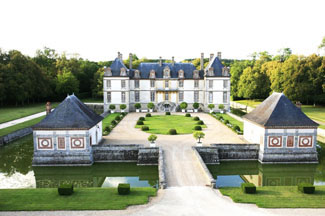 Photos courtesy of Château de Bourron
Photos courtesy of Château de Bourron
14 bis, rue du Maréchal Foch
77780 Bourron-Marlotte
Tel: ++33 (0)1 64 78 39 39
Hotel website
Reserve with Booking.com
9 rooms
Double rooms: 180–370 euros
Suites: 520 euros
Rates include tax and service; breakfast extra
Open: all year
The château is about 8 km south of the town of Fontainebleau. Take D607. As you approach the village of Bourron-Marlotte, turn left on rue du Maréchal Foch.
Trains from Paris leave from the Gare de Lyon (travel in the direction of Montargis and buy tickets at the “Ile de France” ticket office). The station in Bourron-Marlotte is 1 km from the château.
On site: seasonal tennis court; hiking; bicycling
Nearby: Fontainebleau; natural area of Plain of Sorques; Gothic church and fortress of Menours; medieval town of Moret-sur-Loing; Barbizon; 13th-century Château de Blandy-les-Tours; 16th-century
Château de Courances
Yes. Inquire hotel for details.
Step back into the world of French nobility at this authentic and charming moated château. Indeed, your personable and gracious hosts, Guy and Estrella Cordon, are directly related to the Montesquiou-Fezensac family who acquired the castle nearly 140 years ago.
The feeling here is more of a family home rather than a hotel. Need a dinner reservation or advice of how to spend your day? Just let them know!
Spacious guest rooms bear names of historical personages who have had some connection with the castle, such as Marie Leszczynska, wife of Louis XV. You’ll find original 17th-century floor tiles, decorative fireplaces, fine linen wall coverings, and 18th-century furnishings. The bed in one suite sits under a unique gilded arch, while a rough-hewn beamed ceiling and raspberry and cream colored stripped wall coverings feature in La Chambre Vogüé. A false library hides a closet, which used to be a secret passage.
To better keep out the ADD world we live in, guest rooms do not have TVs, but they are equipped with Wi-Fi if you feel the urge to connect.
Bathrooms are well equipped and modernized; some of them feature free-standing eagle claw bathtubs.
The estate extends across 40 hectares of parkland. Walks or bike rides through the woods are a wonderful way to pass time during your stay.
The château does not have a restaurant on site, but the village has four restaurants within walking distance, including Les Prémices, a fine dining room just outside the gate.
![]() Classified historical monument
Classified historical monument